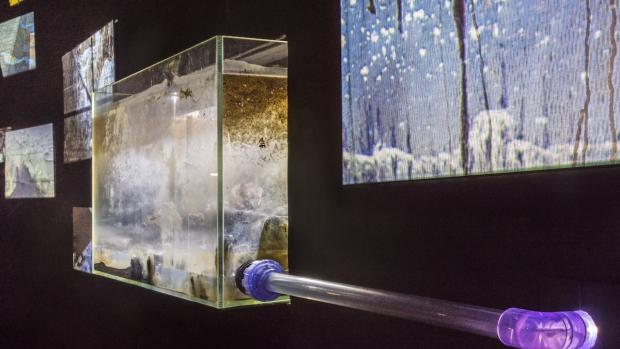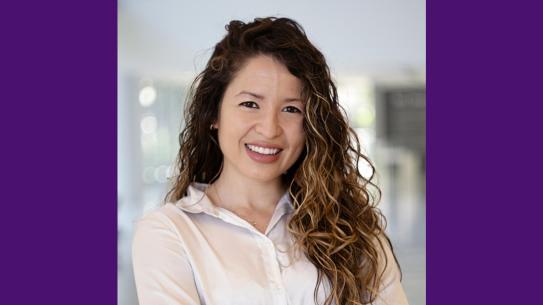Art and engineering on exhibit
Recent exhibits by Tandon faculty members and students highlight the breadth of the work being done here

Part of Assistant Professor Elizabeth Hénaff's installation at the BioBAT Art Space at the Brooklyn Army Terminal
NYU Tandon faculty members have always been engaged in collaborating with museum professionals. Recently, for example, Assistant Professor David Fouhey contributed to a new computer vision system that leverages AI to analyze wing-bone measurements from 1,520 species of passerine birds, providing naturalists with insights into how species evolve and interact with their environments, and Institute Professor Cláudio Silva, who co-directs the school’s Visualization and Data Analytics Research Center (VIDA), led the development of PaleoScan, a first-of-its-kind 3D scanner that allows museum staff to rapidly and easily scan and digitally archive their vast fossil collection.
The list even includes students: master’s degree candidate Chloe Adkins, for example, recently won recognition from the National Science Foundation for her development of an online tool that guides museum professionals in creating tactile objects to enhance the experience of patrons with vision impairments.
Adkins studies in Tandon’s Integrated Design & Media (IDM) program, whose members work at the intersection of art and technology. (IDM co-director, R. Luke DuBois, has exhibited at Spain’s Insitut Valencià d’Art Modern, Switzerland’s Haus der elektronischen Künste, the San Jose Museum of Art; and the Smithsonian American Art Museum, among other venues.)
Recently, two IDM faculty members — Assistant Professor Elizabeth Hénaff and Industry Assistant Professor Kathleen McDermott — each mounted an eye-opening exhibit in Brooklyn.
The process of paying close attention
“Art is entwined with science,” Hénaff says. “They feed each other. While they have different outcomes, both art and scientific research involve paying close attention.”
That was evident in Hénaff’s show at the BioBAT Art Space at the Brooklyn Army Terminal.
She and her team had used advanced DNA sequence analysis on hundreds of species of microorganisms in the highly contaminated Gowanus Canal and made the surprising discovery that many had developed genetically based ways to process heavy metals and degrade pollutants — work that could lead to cheaper, more sustainable ways of cleaning contaminated bodies of water.
Visitors to the BioBAT Art Space, which is connected to one of the borough’s thriving tech incubators, learned about the project after SCOPE and the Hénaff Lab installed over 300 gallons of native Gowanus sediment and water in three aquariums. (Collective Scope currently includes Hénaff, Heather Parrish, Léonard Roussel and Seth Wenger. Their methods involve environmental sampling, bioinformatic analysis, field recording, multi-scale media generation — waiting for things to grow. Scope aspires to construct spaces of close observation that challenge the incumbent hierarchical relationships of nature and culture.)
The 300-gallon water feature is integrated into CHANNEL, a multimedia installation of sculpture, large format prints, spatialized sound, and projection design and has grown over 12 months. While closely observing and maintaining this artwork the team realized the striking similarities between the three-dimensional structures of the biofilms that formed in the aquariums and those that had been filmed in their “natural” environment of the canal.
"These microbes have stories to tell that go beyond scientific data," Hénaff, who is also a member of Tandon's Center for Urban Science + Progress (CUSP), explains.
The utility of things
“I like to remind students that the technologies they are surrounded by are a result of decisions — many of them design decisions — so that they may feel empowered to question those processes,” McDermott has said.
In her recent exhibit, Repair Shop, mounted at the Open Source Gallery in Brooklyn, she and her collaborators posed the questions: When does an item reach the end of its useable lifespan? What defines brokenness? What if one component is irreparable but others can be repurposed for a different use?
One portion of the gallery functions as a showroom, featuring small appliances from McDermott’s own home that no longer perform their original functions but that still have working parts. Using techniques from puppetry and animatronics, she has refashioned them into compelling Rube Goldberg-like pieces, such as a sewing machine whose needle bar sends a pair of false teeth chattering rather than making a hem or joining seams.

Another portion of the space is set up as a shop, where members of the public can donate objects for “repair,” allowing McDermott and her collaborators to alter and repurpose them. (Her fellow artists include Industry Associate Professor Scott Fitzgerald, IDM’s Academic Director, and Kayla DesPortes, an Assistant Professor of Human-Computer Interaction and the Learning Sciences at NYU Steinhardt.)
McDermott points out that several factors come into play when deciding whether an item should be repaired or discarded. “Many people decide that something is not worth fixing simply because it’s quicker to throw it away and purchase a replacement,” McDermott says. “The move away from home repair and DIY repair is a casualty of the time economy. The phrase ‘time for repair’ is used throughout the show. Video pieces (shown on salvaged monitors) make connections between repair of objects, to repair of relationships and other systems of value.”
The gallery space is painted in bright pink — a color chosen based on 1950s advertising tropes of domestic appliances, — prompting visitors to also question the ways in which gender roles and division of labor influence what we value. “Domestic appliances in particular help care for people,” McDermott explains. “As these machines become more complicated, can we make a sustainable plan to care for them in return?”
Carla Gannis takes things “To the Max”
The work of another IDM faculty member, Industry Professor Carla Gannis, was recently shown at the Ro2 Art Gallery, in Dallas, Texas. Her immersive exhibit “To the Max” explores the intersections of identity, technology, and storytelling through a mix of digital and physical media and combines the analog and algorithmic, as well as the personal and the post-human. The exhibit includes her Uncanny Female Objects series, portions of her ongoing wwwunderkammer project, and her renowned Garden of Emoji Delights, a remix of Hieronymus Bosch’s “Garden of Earthly Delights.” (Concurrently, a solo exhibition of Gannis’s moving image work, done from 1998 to the present, can be seen online.)
Curators have asserted that Gannis’s surreal digital figures and reimagined historical iconography create a vibrant space where technology acts as both collaborator and provocateur. She aims, as she says, to build a world in which “technology doesn’t replace the human experience but magnifies, complicates, and transforms it.”
IDM Showcase — A new cohort of creative technologists
The end-of-semester showcase organized by IDM is a reliable crowd-pleaser, as visitors to the Spring 2025 edition can attest. Whether they were playing an old-school weather-simulation game set in New York City, watching the construction of a wooden vessel, or interacting with a touch-sensitive sculpture, there was plenty to do and see for all ages. To learn more about the dozens of senior and graduate projects, which were arrayed throughout three floors of 370 Jay Street, visit idm.show/S2025




